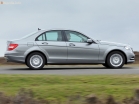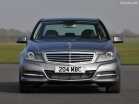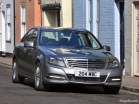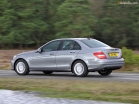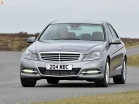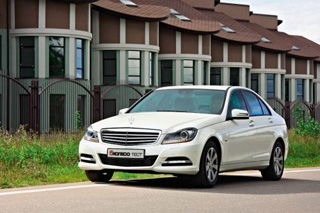Test drive Mercedes Benz S-Class Sedan since 2011 sedan
Tempus Fugit
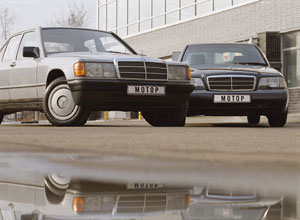 On the eve of the Geneva Motor Show, the Daimlerchrysler AG Corporation arranged dinner for journalists. A kind of reporting meeting. It all started with a performance in which the audience was offered to think about what the spirit of Mercedes is. The actress, who threw this issue into the hall, immediately appeared the spirit of Wilhelm Maybach. After a short excursion into history, which was accompanied by phrases like: eh, it is not easy to be a legislator of world fashion, the ghost of the famous engineer rolled out a layout of 1: 5 on stage and exclaimed: finally I created the perfect car that embodies the spirit of Mercedes!. After that, the head of the Mercedes-Benz passenger car, Jurgen Hubbert, flirtingly brushing the dustproof from the layout, said: here!.
On the eve of the Geneva Motor Show, the Daimlerchrysler AG Corporation arranged dinner for journalists. A kind of reporting meeting. It all started with a performance in which the audience was offered to think about what the spirit of Mercedes is. The actress, who threw this issue into the hall, immediately appeared the spirit of Wilhelm Maybach. After a short excursion into history, which was accompanied by phrases like: eh, it is not easy to be a legislator of world fashion, the ghost of the famous engineer rolled out a layout of 1: 5 on stage and exclaimed: finally I created the perfect car that embodies the spirit of Mercedes!. After that, the head of the Mercedes-Benz passenger car, Jurgen Hubbert, flirtingly brushing the dustproof from the layout, said: here!. The car, whose layout was shown to journalists, is destined to replace the current C-class this year. Recall how it all began ...
They began to work on the C-class car (W-202) when his predecessor Mercedes 190 (W-201) was already scolded for tightness in the rear seats. In 1993, the C-class became a worthy successor of the glory of one hundred nineties and the Redeemer of his sins. Therefore, we will begin the history of C-class with the background.
In the early eighties, photographers-spions were knocked down, hunting a small sedan of the mysterious brand of USHIDO. It turned out that it was not the Japanese at all prepared for landing in Europe, and Daimler-Benz is experiencing its new model ...
Professor Werner Breitshwerdt, President of Mercedes-Benz, withstood a decent pause, not commenting on the pictures published in the press and sketching of the wedge-shaped body. Otherwise, what is a surprise?
The Mercedes 190 (W-201) came to a state of full combat readiness in the fall of 1982. The premiere to a large international exhibition failed to guess the Frankfurt car dealership only next year, but there was nothing to catch in the Parisian, since all the laurels on it were obviously supposed to get the Audi 100 direct competitor Mercedes 190. And any new novelty from Mercedes was required to cause a sensation (in Those years of the company still succeeded). And a million visitors to the Paris car dealership did not see one hundred nineties. The debut was so important for Daimler-Benz Ag until November. The sensation took place, but the Audi 100 model still became a 1983 car ...
Mercedes 190, who received the nickname of Baby-Benz, caused universal delight. Especially his suspension, which endowed one hundred and nineties completely atypical for the car of the classical layout by behavior. The car was twisted from neutral to insufficient, did not show any tendency to scream at high speed.
Such a story went to the circle of Russian automobile engineers. At one time, Daimler-Benz brought the 190th model to the Dmitrov Auto Polygon so that we have met the employees of us. Having swept in a car, the famous designer Boris Fitterman, an ardent adherent of the front -wheel drive, excitedly moved his big ears: it is necessary that these devils made an idea of \u200b\u200ba car with a classic layout, and behaves like a front -wheel drive ...
The production of Mercedes 190 (at the rate of 100,000 cars per year) began in Zindelfingen, on the same conveyor thread where the W-123 was collected. In the spring of 1984, just before the launch of the plant in Bremen with a capacity of 140,000 one hundred and nineties per year, a festive wreath on the hood of a hundred thousandth car was laid in Zindelfingen. The Swabs showed their characteristic prudence: the local plant produced cars for German and European buyers, and the northern colleagues who had a giant port were entrusted to the overseas market and the special execution of the machine (there was another division of labor: there was powerful press equipment in Zindelfingen, And there the sidewalls of the body and roof were stamped, and the Bremen plant supplied the doors to both production) ...
Initially, Mercedes 190 was offered with 2 l 4-cylinder engines (90 hp carburetor, 122 hp injector). In 1983, at the Frankfurt Motor Show, the most popular modification, the 190s 2.3, equipped with a 2.3 l 16-valve engine with a capacity of 185 hp. It was on this car in the summer of 1983 that a world record was set on the ring track in the NARDO 50 thousand kilometers with stops for refueling were passed in 201 hours, 39 minutes and 43 seconds.
 Simultaneously with the 190s, 2.3 debuted the 190D option with 2 L 72-horsepower diesel. By September 1984, the power of the carburetor engine was raised to 105 hp, 2.3 l of an injector engine with a capacity of 136 hp appeared.
Simultaneously with the 190s, 2.3 debuted the 190D option with 2 L 72-horsepower diesel. By September 1984, the power of the carburetor engine was raised to 105 hp, 2.3 l of an injector engine with a capacity of 136 hp appeared. In October 1985, in Frankfurt, versions with a in-line six (2.6 liters, injection, 166 hp) and Mercedes 190d 2.5 with a 5-cylinder 90-horsepower diesel engine were rolled.
In 1986, at the exhibition in Paris, they presented the 190E 2.6 ASD modification, equipped with a self -locking differential with a hydraulic drive and an executive mechanism in the form of multi -disc packages of couplings. In 1988 (when all gasoline versions, due to the total installation of neutralizers, weakened several horses) appeared 190d 2.5 Turbo with a 122-horsepower turbodiesel and additional sampling in the right front wing to improve the air supply. In the same year, 2.3 liters of a 16-valve engine were also replaced by 16-valve, but 2.5 liters, with a capacity of 195 hp. Then a millionth one hundred nineties came off the assembly line ...
In motorsport, Mercedes 190 debuted on May 12, 1984, driving a car with a 2.3 l 16-valve engine with a capacity of 185 hp. Ayrton Senna was. One hundred and nineties participated in the DTM Cup won 50 times. Sports success prompted to release the charged version of Evolution II to the market (in the spring of 1990), the main external differences of which were an aerodynamic skirt and a huge rear anti -wing. The car was equipped with a 2.5 liter of a 16-valve engine, forced AMG workshop to 373 hp. For DTM races. The serial Evolution II engine developed 234 hp. at 7200 vol./min.
In April 1990, an important event took place rejection of the carburetor in favor of injection. Version 190e 1.8 had an engine with a capacity of 109 hp. In 1992, Mercedes-Benz proposed the concept of Lines car decoration, for one hundred and nineties three design options were offered: Azurro, Rosso, Verde. On October 14, 1993, the last Mercedes 190 silver color went to the factory museum directly from the assembly line. In total, the company produced 1.879.630 cars with the body of W-201 ...
The development of the heir to one hundred nineties began with abstract experiments, including an all -wheel drive and even with a full -fired model created under the motto a car that does not require parking assistance. The outlines of a full-size W-202-based full-sized model were started in early 1987.
It was a period when the automobile design, figuratively speaking, sharply braked at the intersection in front of a suddenly flashed red -free traffic light. The wedge-shaped forms of the bodies with sharp, chopped faces, which were so fond of in the 80s, suddenly crushed everyone. For six months, designers of the head studio in Zindelfingen worked on large -scale (1: 5) plasticine layouts of the future sedan. Forms W-202 were much softer, more rounded than that of one hundred nineties. Then they made full -sized plasticine layouts: five appearance and four interiors. A year after the start of work, the main features of the body of the W-202 body were determined. Properly executed in the little things, the new appearance was not as solid as that of the predecessor. At that line of the body, they seemed to rush to the chrome cladding of the radiator, a kind of crown of the whole composition. Now, the form turned out to be collapsed: the back of the body played for itself (the backlays of the back lamps of the designers), the front for itself. The new block factors had multi-focus reflectors with three separate zones for near, far and fog light. In contrast with one hundred and nineties, the C-class embarrassed the gap of the radiator ridiculously planted on the hood with the radiator cladding.
In 1988, the first running prototype was built. He (as well as subsequent experimental samples) for masking carries the body of one hundred nineties, since at this stage the size and design did not matter. Meanwhile, the bodywriters manually built, as they called it, the running pre-prototype, which was used to verify the fidelity of the chosen concept of the body.
In the summer of 1989, the final design version was presented to the board of directors of the company, after which the work on the machine entered the final stage. In June next year, equipment was made for the construction of the first prototypes, more than fifty of them were manufactured.
The machine turned out a little more than its predecessor: length 4478 mm (+30 mm), width 1720 mm (+30 mm), height 1414 mm (+39 mm), base 2690 mm (+25 mm). This made it possible to increase the living space of the rear passengers. The distance from the back of the front chair to the rear is increased to 684 mm (+19 mm), the height from the sofa pillow to the roof to 965 mm (+31 mm).
The suspension became tougher, stabilizers appeared in front and back (the exclusion of the model C180 and C200, they were able to do with more rigid springs from behind).
I must say, from the very beginning of work on the machine, the 5-red rear suspension of one hundred nineties was considered as the most suitable. It was a great success of the design bureau in Zindelfingen: it is known how difficult it is to achieve the same handling on small and light cars when the loading changes. The five -widow, which, incidentally, appeared long before the vaunted Japanese multi -link suspensions, did a joke with this task. When loading the car, the angle of convergence of the rear wheels did not change, during the operation of the suspension the context and the track changed slightly, the rear wheels constantly retained a negative collapse, which improved the behavior of the car in corners. Adaptation of the suspension to the increased mass of the machine and the changed base and the rut was limited mainly by the selection of rubber bushings.
A serious innovation on part of comfort was established on hydraulic supports that extinguish noise and vibration. Moreover, the hydropneumatic rear suspension racks made it possible to maintain the body position regardless of the workload ...
It was more difficult with the front suspension. We experienced several options, and in the end we stopped on the kinematic S-class scheme: the transverse levers, springs and depreciation racks significantly spaced in height. This design provided minimal changes in the collapse and the convergence of the wheels at the compression and end moves, as well as neutral rotation. In addition, it was possible to obtain from the steering with recirculating balls of characteristics close to the fact that they are characteristic of a more progressive gear-rake. The front suspension design made an unnecessary adjustment of the longitudinal angle of inclination of the pins and the collapse of the wheels. We note before the car reached the roads of the landfill, the elastokinematic properties of the suspension and vibrations were modeled on the computer.
From the very beginning, the C-class was proposed in much larger, compared to one hundred and nineties, the number of options: 4 model executions (Classic, Esprit, Sport, Elegance), 7 engines, 17 colors. It was part of the standard equipment that was served by an electronic system of a new generation, the main processor of which could be programmed for various executions of the model, for example, for a specific dimension of tires.
The engineers had to face other no less curious problems. Time demanded that a hatch appear in the partition between the interior and trunk of the car. And he appeared. After that, the weakened back of the body began to play, vibrations through the roof were transferred to the front shield of the body, and from it to the steering. The driver felt this especially well with poor balancing the rear wheels. I had to replace the back wall of the body with a hard bilateral frame, which was also equipped with powerful locks that held the back of the seat during sharp braking or collision when the contents of the trunk strove to get into the salon. It is clear that vibrations cannot be reduced by a straight thickening of body panels. The designers used small tricks, for example, they made the floor under the feet of the rear passengers slightly convex and glued the rear window into the frame to give additional stiffness the body as a whole.
During the aerodynamic refinement of the body form (and the CC coefficient in different modifications is 0.30-0.32), considerable attention was paid to a decrease in noise. In this regard, the thickness of the side glasses was increased by 1-4 mm, air deflectors appeared on the front rack stands near the fastening of external mirrors. Safety parameters improved at the same time. So, for example, the area of \u200b\u200bthe windshield at the C-class is 10% more than that of one hundred and nineties, which has improved overview ...
The public show of Mercedes-Benz C-class took place in June 1993. In the traditions of one hundred and nineties, the car hit all exhibitions. At the Autumn Frankfurt Motor Show, the novelty has become a central exhibit. The machine was offered in the options C180 (1.8 liters, 4 cil., 122 hp), C200 (2 l, 4 cil., 136 hp), C220 (2.2 l, 4 cil., 150 L.S.), C280 (2.8 L, 6 CIL., 193 hp), C36 AMG (3.6 l, 6 Tsil., 280 hp), c200 d (2 l, 4 Tsil., diesel, 75 hp), c220 d (2.2 l, 4 cil., diesel, 95 hp) and C250 D (2.5 l, 5 cil., Diesel, 113 l. With.). The engines had 4 valves on the cylinder and aggregated both with a 5-speed mechanical and 4-speed automatic transmission.
In the summer of 1995, the premiere of the compressor version of the machine, the 2.3 liter of the engine of which developed 193 hp, took place. In the winter of 1996, the Kombi T modification debuted with the station wagon, which was distinguished by a slightly altered track, larger (4516 versus 4478 mm), increased by 60-110 kg, depending on the modification, mass. The volume of the trunk with folded seats was 1510 liters. All modifications were produced with the station wagon, including AMG. In 1997, the 113-horsepower diesel replaced his 2.5-liter 5-cylinder turbocharged counterpart with a capacity of 150 hp ...
On April 28, 1997, an updated S-class model range appeared before the public. Side airbags were introduced, Brake Assist, seat belt tensioners, electronic key all as standard equipment. Three new engines appeared: a 125-horsepower diesel with direct CDI injection, 4 valves on a cylinder, turbocharger and intercooler for the C220 Turbodiesel model, 170-horsepower V6 gasoline engine with a cylinder for a C240 \u200b\u200bmodel that replaced C230, and a top-end 197-horsepower Basin V6 with 3 valves on the cylinder and double ignition for C280. The list of additional equipment included many electronic systems installed on the E- and S-class models.
In April 1997, a millions of C-class C-230 Model performed by Sport came off a conveyor in Zindelfingen. In the same year, a version of C43 AMG, equipped with a 4.3 -liter V8 engine with a capacity of 306 hp, debuted at the Frankfurt car dealership. The first and so far the only eight in the history of the Baby-Ben.
The C-class sports model, AMG version, from 1994 to 1996, won places on the catwalk 34 times in the DTM and ITC racing series.
Tempus Fugit. Time flies. It was time to overwhelm this page of automotive history. Seven years have passed since the start of the Mercedes C-class. Sold over 1.6 million cars. A more than successful career of the current model is completed. But life goes on. At the end of March, I saw the light of a completely new Mercedes C-class. Its creation took four years and about 1.4 billion EVRO.
We will not describe the appearance of the car, everything is clearly visible in the photo. The creators of the new compact Mercedes sought dynamism and elegance for this. They seemed to deal with the task ... The car received a base increased by 25 mm and became a little longer. The track is slightly expanded. The salon is now more spacious. A third of the body has increased by a third, its aerodynamic characteristics have been improved.
In the range of four gasoline and three diesel engines are new and modernized, atmospheric and with superchargers, with a power of 115 to 218 hp. (with the most powerful 3.2 l V6, the car develops 245 km/h and accelerates to hundreds in 7.8 seconds). In the steering mechanism, instead of the previous balls, a gear-rake. A new 6-speed mechanical box, re-designed pendants and many other innovations ...
On sale, the car will appear in May. Look forward to.
Denis Orlov
Source: Motor magazine [April 2000]

